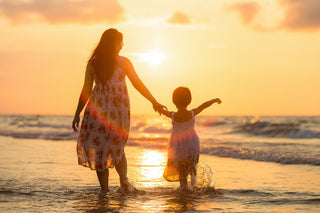Hot and humid weather poses a heightened risk for children to develop a heat rash, commonly referred to as "prickly heat."
During hot weather, active children, especially those engaged in outdoor play or dressed inappropriately for the climate, are particularly susceptible to developing a heat rash. Wearing clothes that do not allow the skin to breathe can exacerbate the situation by increasing sweat accumulation on the child's skin, which in turn raises the likelihood of heat rash development.
Excessive sweating can lead to the blockage of a child's pores, which are the ducts of their sweat glands. The trapped perspiration under the skin can cause irritation, redness, and sometimes an itchy rash.
What does heat rash look like in children?
In children, heat rash appears as small bumps surrounded by red skin. Though kids may experience a prickly sensation, it is generally not painful.
Infants typically develop the rash on their neck, armpits, elbow creases, and groin, while older children may also experience it on their chest and back. Heat rash typically does not affect the eyes, nose, mouth, palms, or soles of the feet. If your child develops a heat rash, you can expect them to continue acting normally. A child with a heat rash shouldn't have a fever or other signs of illness.
How to alleviate heat rash:
If you suspect your child has a heat rash, it's crucial to initiate the cooling-down process immediately. Follow these guidelines:
During hot weather, active children, especially those engaged in outdoor play or dressed inappropriately for the climate, are particularly susceptible to developing a heat rash. Wearing clothes that do not allow the skin to breathe can exacerbate the situation by increasing sweat accumulation on the child's skin, which in turn raises the likelihood of heat rash development.
Excessive sweating can lead to the blockage of a child's pores, which are the ducts of their sweat glands. The trapped perspiration under the skin can cause irritation, redness, and sometimes an itchy rash.
What does heat rash look like in children?
In children, heat rash appears as small bumps surrounded by red skin. Though kids may experience a prickly sensation, it is generally not painful.
Infants typically develop the rash on their neck, armpits, elbow creases, and groin, while older children may also experience it on their chest and back. Heat rash typically does not affect the eyes, nose, mouth, palms, or soles of the feet. If your child develops a heat rash, you can expect them to continue acting normally. A child with a heat rash shouldn't have a fever or other signs of illness.
How to alleviate heat rash:
If you suspect your child has a heat rash, it's crucial to initiate the cooling-down process immediately. Follow these guidelines:
- Remove your child from the heat and bring them to a cooler area.
- Use a fan to cool them down.
- Take off any extra clothing they may be wearing.
- Use a cool, damp washcloth to wipe away sweat and body oils.
- Pat the skin dry to remove excess moisture.
Avoid using lotions, oils, creams, or ointments on the affected skin, as these can further clog the pores, trap moisture, and worsen the heat rash. Instead, children over 3 years of age can benefit from applying cooling body powders like Snake Brand Prickly Heat Powder. This will quickly soothe the skin and keep the sweat ducts open, preventing further blockages.


